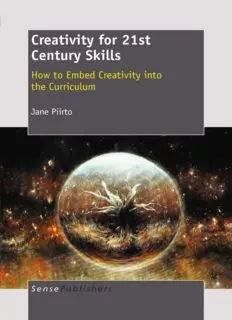
Creativity for 21st Century Skills: How to Embed Creativity into the Curriculum PDF
Preview Creativity for 21st Century Skills: How to Embed Creativity into the Curriculum
st Creativity for 21 Century Skills st Creativity for 21 Century Skills How to Embed Creativity into the Curriculum Jane Piirto Ashland University, Ohio, USA SENSE PUBLISHERS ROTTERDAM/BOSTON/TAIPEI A C.I.P. record for this book is available from the Library of Congress. ISBN: 978-94-6091-461-4 (paperback) ISBN: 978-94-6091-462-1 (hardback) ISBN: 978-94-6091-463-8 (e-book) Published by: Sense Publishers, P.O. Box 21858, 3001 AW Rotterdam, The Netherlands www.sensepublishers.com Printed on acid-free paper All Rights Reserved © 2011 Sense Publishers No part of this work may be reproduced, stored in a retrieval system, or transmitted in any form or by any means, electronic, mechanical, photocopying, microfilming, recording or otherwise, without written permission from the Publisher, with the exception of any material supplied specifically for the purpose of being entered and executed on a computer system, for exclusive use by the purchaser of the work. DEDICATION To Steven, Denise, and Danielle (of course) v CONTENTS Preface.....................................................................................................................ix Acknowledgements...............................................................................................xiii Author Biography.................................................................................................xvii 1. Creativity for 21st Century Skills.........................................................................1 2. Five Core Attitudes............................................................................................13 3. The Seven I’s: Inspiration..................................................................................43 4. The Six Other I’s...............................................................................................89 5. General Practices for the Creative Process......................................................117 6. Working Creatively Within an Institution.......................................................143 Appendix A: The Piirto Pyramid of Talent Development....................................157 Appendix B: Focus Questions for Classes Using this Book................................165 Notes....................................................................................................................169 References............................................................................................................177 Index....................................................................................................................187 vii PREFACE I’ve been teaching since 1964, when I was a young mother and graduate assistant in the English department, while getting my first master’s degree. My take on creativity enhancement comes from a many-factored background that few who write in the education and psychology area have. I have been a teacher, an education and English professor, a school and college administrator for all levels, from pre-K through doctoral dissertations and I’m also a published and award-winning poet and novelist. That artist/education/ professor background has led me to some experiences and conclusions about the creative process that may be a little different from those you usually read about in books like this, and which have in turn led me to writing this book.1 In 1977, I was working on my first book-length scholarly tome, my dissertation, and the placement office called up and asked me whether I wanted a part-time job in the education of the gifted. I jumped at the chance to make some money, as my university doctoral fellowship had run out. For my interview, I went to the library and read up about gifted children. During the preparation for the interview, I looked at the federal categories of giftedness. These were (1) superior cognitive ability, (2) specific academic ability, (3) visual and performing arts ability, (4) psychomotor ability, and (5) creative thinking ability. Now this experience is where the dissonance that precipitated this book began. How are people “gifted” in “creative thinking,” I asked myself? I understood about very smart people, people who were better at one school subject than another, people who were gifted at visual arts, theater, music, and dance, and people who were good at various individual sports, but creative thinking? I asked myself, “Aren’t smart people creative? Aren’t people good at academic subjects creative? Aren’t visual and performing artists creative? Aren’t athletes creative? Why is there a separate category for creativity? Aren’t all children creative, unless they’ve been abused or something?” Hold that thought. The Dissonance Between My Creative Life and My Paying Job For extra money, while getting my Ph.D., I had applied and was accepted by the Ohio Arts Council to be a teaching artist as a Poet in the Schools in the National Endowment for the Arts “Artist in the Schools” program. My dual life as an artist and as an education scholar had begun, as I published my first creativity article, and my first article submitted to a scholarly journal, in the Gifted Child Quarterly, on incubation in the creative process, and later presented my first creativity study at a national conference, a survey of my fellow writers in the Artist in the Schools program about their lives and their creative processes. This was soon after I began my career in the education of the gifted and talented. ix
